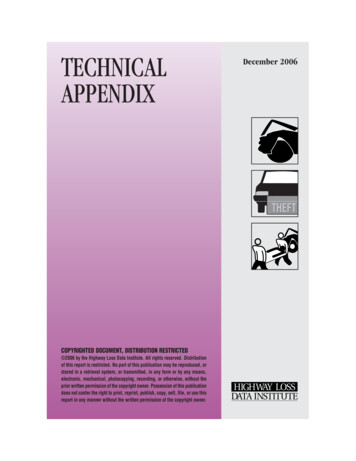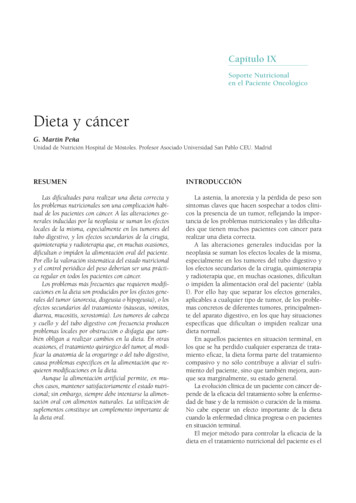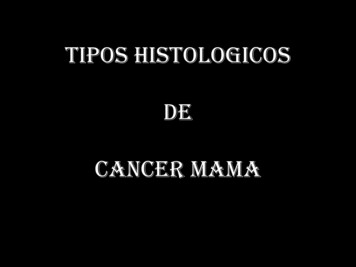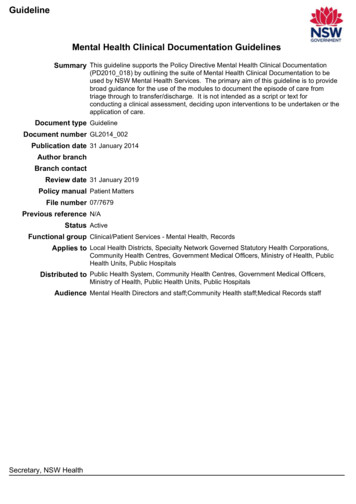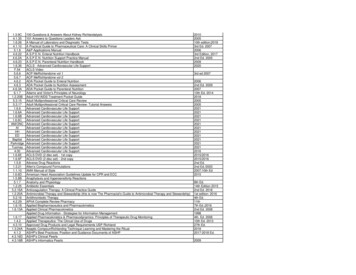
Transcription
Clinical and Translational CLINICAL GUIDES IN ONCOLOGYSEOM‑GEICO clinical guidelines on endometrial cancer (2021)María Pilar Barretina‑Ginesta1 · María Quindós2 · Jesús Damián Alarcón3 · Carmen Esteban4 · Lydia Gaba5 ·César Gómez6 · José Alejandro Pérez Fidalgo7 · Ignacio Romero8 · Ana Santaballa9 · María Jesús Rubio‑Pérez10Accepted: 26 January 2022 The Author(s) 2022AbstractEndometrial cancer (EC) is the second most common gynecological malignancy worldwide, the first in developed countries[Sung et al. in CA Cancer J Clin 71:209–249, 2021]. Although a majority is diagnosed at an early stage with a low risk ofrelapse, an important proportion of patients will relapse. Better knowledge of molecular abnormalities is crucial to identifyhigh-risk groups in early stages as well as for recurrent or metastatic disease for whom adjuvant treatment must be personalized. The objective of this guide is to summarize the current evidence for the diagnosis, treatment, and follow-up of EC, andto provide evidence-based recommendations for clinical practice.Keywords Endometrial cancer · Guideline · Diagnosis · TreatmentM. P. Barretina-Ginesta, M. Quindós, J. D. Alarcón, C. Esteban,L. Gaba, C. Gómez, J. A. Pérez Fidalgo, I. Romero, A. Santaballa,and M. J. Rubio-Pérez have contributed equally to the writing ofthe manuscript.2Medical Oncology Department, Complexo HospitalarioUniversitario de A Coruña. Biomedical Research Institute(INIBIC), A Coruña, Spain3Medical Oncology Department, Hospital Universitari SonEspases, Fundació Institut d’Investigació Sanitària IllesBalears (IdISBa), Palma, SpainMaría Quindósmaria.quindos.varela@sergas.es4Medical Oncology Department, Complejo Hospitalario deToledo, Toledo, SpainJesús Damián Alarcónjesus.alarcon@ssib.es5Medical Oncology Department, Hospital Clínic of Barcelona,Therapeutics in Solid Tumors, Translational Genomicand Targeted, Institut d’Investigacions Biomèdiques AugustPi i Sunyer (IDIBAPS), Barcelona, Spain6Department of Medical Oncology, Infanta Sofíaand Henares Hospitals Foundation for Biomedical Researchand Innovation (FIIB HUIS HHEN), Infanta Sofía UniversityHospital, Madrid, Spain7Medical Oncology Department, Hospital ClínicoUniversitario of Valencia. Biomedical Research InstituteINCLIVA. CIBERONC, Valencia, SpainIgnacio Romeroiromero@fivo.org8Department of Medical Oncology, Fundación InstitutoValenciano de Oncología (IVO), Valencia, SpainAna Santaballaanasantaballa@gmail.com9Medical Oncology Department, Hospital Universitari iPolitècnic La Fe, Valencia, SpainMaría Jesús Rubio‑Pérezmjesusrubio63@gmail.com10Medical Oncology Department, Hospital Universitario ReinaSofía. University of Córdoba, Córdoba, Spain* María Pilar en Estebancarmen.estebanesteban@gmail.comLydia Gabalgaba@clinic.catCésar Gómezcgomezraposo@gmail.comJosé Alejandro Pérez Fidalgojapfidalgo@msn.com1Medical Oncology Department, Institut Català d’Oncologia(ICO), Department of Medical Sciences, Girona BiomedicalResearch Institute (IDIBGI). Department of MedicalSciences, Medical School University of Girona (UdG),Girona, Spain13Vol.:(0123456789)
Clinical and Translational OncologyIntroductionEndometrial cancer (EC) is the most common gynecologicalcancer, following cervical cancer, in developed countries.Most patients are diagnosed at an early stage with a lowrisk of relapse. In the last 30 years, incidence has increasedin a proportion of 1% per year, associated with higher mortality. Age at diagnosis and comorbidities (e.g. diabetes,hypertension and obesity) make treatment of EC challenging and might increase mortality. The high rate of cure ininitial stages with an OS at 5 years around 80–85% havecreated the false belief that EC is a low-risk disease. Yet,advanced stages and some histologies are associated withpoor prognosis.MethodologyThis guideline is based on relevant published studies andwith the consensus of ten EC treatment expert oncologistsfrom GEICO (Spanish Group for Investigation in OvarianCancer) and SEOM (Spanish Society of Medical Oncology). The Infectious Diseases Society of America-US PublicHealth Service Grading System for Ranking Recommendations in Clinical Guidelines [2] has been used to assignlevels of evidence and grades of recommendation.DiagnosisThe most frequent symptom of EC is abnormal uterinebleeding. In postmenopausal women or those with riskfactors, metrorrhagia should always be investigated. Transvaginal ultrasound (TVUS) is usually performed given itsavailability and low cost. The cutoff level of 3 mm forexclusion of EC in women with postmenopausal bleedingis widely recommended [II, B], whereas no establishedconsensus for premenopausal women [3] has been established. Histologic confirmation is always required. Blindendometrial biopsy is preferred although false negativeresults are frequent. In such cases, hysteroscopy withtargeted biopsy could be recommended. In patients whocannot tolerate an office biopsy or for those with an unsuccessful office procedure, dilation and curettage, with orwithout hysteroscopy, is an option.Preoperative imaging and histologic features help intailoring the surgical approach to avoid unnecessary lymphadenectomy (LND) in low-risk patients [4]. TVUS canaccurately evaluate myometrial invasion in most cases(80%) but it is less sensitive for cervical stromal invasion.13Contrast-enhanced magnetic resonance imaging is thebest method for detecting myometrial invasion or cervicalinvolvement and it is highly recommended especially whenconservative fertility preservation treatment is planned andin inoperable patients referred to radical radiation. At leastan abdomino-pelvic computerized tomography scan (CTscan) must be performed to rule out lymph node (LN) ordistant metastasis. Positron emission tomography/CTscancan also be employed. Thorax CTscan should also be performed as part of the initial assessment to exclude lungmetastases in high-risk cases. The role of serum tumormarkers is unclear [IV, B].Hereditary endometrial cancerAround 5% of EC cases have an inherited mutation inMismatch Repair (MMR) genes, namely MLH1, MSH2,MSH6, PMS2 or EPCAM [5]. The diagnosis of LynchSyndrome is based on the detection of the germline mutation. Screening of Lynch Syndrome is currently recommended for all EC cases with no limitations regarding theage or the histology type [6] [IIA]. Screening of Lynchsyndrome is based in the detection of MMR protein loss(MMR deficiency). When MMR-D is present, to rule outa non-hereditary cause, the MLH1 methylation or, morerarely, a BRAF mutation can be performed. If none ofthese are identified, a germline analysis of MMR genesmust be undertaken. When carriers are identified, theymust be advised of the specific lifetime risk of colorectal cancer ranging from 20% in PMS2 to 70% in MLH1and other Lynch syndrome tumors. Moreover, this shouldprompt the direct mutation analysis of relatives to helpidentify carriers and to offer women prophylactic salpingoophorectomy and hysterectomy once childbearing is completed [IV, B].Other less frequent EC hereditary syndromes can becaused by PTEN germline mutations in Cowden syndrome,( 1%) [7], germline mutation in BRCA1/2 (1%) with controversy regarding the association to serous histology [8] andgermline TP53 mutations in Li-Fraumeni syndrome ( 1%).ScreeningThere are no high-quality data to support the efficacy ofscreening with imaging, tissue sampling, or cervical cytology for reducing EC mortality. Thus, in women with average or high-risk for endometrial cancer without abnormal
Clinical and Translational Oncologybleeding, routine screening is not recommended [II, A]. Thisincludes patients on tamoxifen, although there are no reliabledata in women with extended therapy beyond five years.Women with Lynch syndrome have a lifetime riskof endometrial cancer of 13–71%. Annual endometrialsampling, TVUS and CA125 beginning at age 30–35 or5–10 years prior to the earliest age of first diagnosis ofLynch-associated cancer of any kind in the family is recommended [IV, B].Pathology and molecular biology of ECEpithelial EC is divided into different histologic subtypes:1.2.3.4.5.Endometrioid carcinoma.Serous carcinoma.Clear cell carcinoma.Uterine carcinosarcoma.Other: mucinous, neuroendocrine, undifferentiated,dedifferentiated carcinomas.Endometrioid adenocarcinomas (EEC) are the most frequent subtype ( 80%). EEC is a heterogeneous subgroupthat varies from indolent to very aggressive carcinomas.After tumor stage, the next most informative prognostic division in EEC is between high grade (grade 3) and low grade(grade 1–2). Despite the three-grade classification is widelyused, a binary FIGO (International Federation of Gynecology and Obstetrics) grade is recommended: low grade (1–2)vs high grade (3) [9].Serous carcinomas (SC) are the second most frequentendometrial carcinomas ( 10%). This subtype is aggressiveand is frequently associated with deep myometrial involvement and lymphovascular invasion. More than 90% of SCare associated with TP53 mutations.Clear cell carcinomas (CCC) are a rare subgroup (1–6%)characterized by the clearing of tumor cell cytoplasm.Patients with CCC are more likely to present with a higherFIGO stage than EEC and have a poorer prognosis [10].Uterine carcinosarcoma (UCS) is a highly aggressivetumor with a mixture of malignant epithelial and mesenchymal/sarcomatous components. UCS is very rare ( 1.5%).Next generation sequencing (NGS) analyses have revealedthat UCS are serous-like tumors. The sarcoma dominance(presence of 50% of sarcomatous element) is associatedwith worse prognosis [11].Eventually EEC can coexist in the presence of SC orCCC, when one of these components are present in at least5% it is classified as a mixed carcinoma.Every subtype has been associated with different molecular alterations [12]. Table 1.Table 1 Frequency of most common targeted alterations in endometrial cancer according to histological subtypePTEN mutationPI3KCA mutationPIK3R1 mutationKRAS mutationFGFR2 mutationCTTNB1 mutationMMR-dARID1A mutationP53 mutationERBB2 amplificationPOLE mutationEECSCCCC UCS64–80% G1–352–82% G1/G262–90% G322–59% G1–G338–54% G1/G245–59% G39–43% G1–G319–38% G1/G231–41% G319–43% G1–G317–23% G1/G27–33% G310–18% G1–G311–13% G1/G214–16% G319–37% G1–G324–28% G1/G219–40% G334–35% G1–G334% G1/G244% G339–55% G1–G339–47% G1/G239–60% G35–14% G1–G36–10% G1/G221–35% G31% G1–G33% G1/G24% G313–15% G1–G311% G1/G220% G32–3%0–21%11–33%15–35% 24–36% %0%0–2%0–3%0%0–5%0–3%11–14% 3–6%7–11%14–21% 10–24%59–93% 28–46% 44–91%26–44% 11%9%0–2%3–4%2–7%Modified from Urick and Bell [12]Molecular classificationIn 2013, The Cancer Genome Atlas (TCGA) ResearchNetwork published an integrated genomic analysis of 373EC. The analyses identified four prognostic categories ofEC: POLE (ultra-mutated) (7%), microsatellite instability(MSI)/hypermutated (28%), copy number low/microsatellitestable (39%), and serous-like/copy number high (26%) [13].POLE ultra-mutated is a subgroup characterized bysomatic mutations in polymerase epsilon DNA polymerase(POLE) exonuclease domain which results in a high mutation rate. POLE is more frequently presented in low-gradeand high-grade EEC. This subtype has an excellent prognosis and rarely recurs.Microsatellite instability high (MSI-h) subtype is characterized by a deficiency in the MMR system that leads to anhypermutated status. Most MSI-h tumors are EEC.13
Clinical and Translational OncologyTable 2 Relationship betweenhistotype and molecularclassificationEEC G1-2EEC G3SCCCCUCSNSMP 50%10-50% 10% 50% 10%MMR-d/MSI10-50%10-50% 10% 10%10-50%POLE-mut 10%10-50%0% 10% 10%P53 abn 10%10-50% 50%10-50% 50%Modified from Huvila J et al. [15]Table 3 2009 FIGO staging system for endometrial cancerStage IIAIBStage IIStage IIIIIIAIIIBIIIC1IIIC2Stage IVIVAIVBTumor confined to corpus uteri, including endocervical glandular involvementTumor limited to the endometrium or invading less than half the myometriumTumor invading one half or more of the myometriumTumor invading the stromal connective tissue of the cervix but not extending beyond the uterusTumor involving serosa, adnexa, vagina, or parametriumTumor involving the serosa and/or adnexa (direct extension or metastasis)Vaginal involvement (direct extension or metastasis) or parametrial involvementRegional lymph node metastasis to pelvic lymph nodesRegional lymph node metastasis to para-aortic lymph nodes, with or without positive pelvic lymph nodesTumor invading bladder and/or bowel mucosa, and or distant metastasisTumor invading the bladder mucosa and/or bowel mucosaDistant metastasis (includes metastasis to inguinal lymph nodes, intra-peritoneal disease, lung, liver, or bone)The copy number (CN) low subgroup also called microsatellite stable, includes most of low-grade endometrioidtumors.The CN high subgroup is frequently harbors TP53 suppressor gene mutations and includes almost all SC and mostof mixed type carcinomas and carcinosarcomas.The complexity of the TCGA classification led to establishing more practical and feasible molecular classifications.The Leiden/TransPORTEC and the Vancouver/PROMISEstudies generated two new classifications that are similarin molecular alterations. Although they are not identical toTCGA, these new classifications are preferred for clinicalpractice. They established four subgroups according to MSIstatus, POLE and TP53 mutations. These four subgroupsdefined in thePORTEC study are:1.2.3.4.POLE-mutant.Microsatellite instable.p53 abnormal.No specific molecular profile (NSMP) [14] (Table 2).associated at risk of recurrence to identify patients whomay benefit from adjuvant therapy. Currently, well-definedclinicopathologic prognostic factors include: histological subtype, tumor differentiation grade, FIGO stage, age,depth of myometrial invasion and lymphovascular spaceinvasion (LVSI) [17]. All these factors must be reportedin the pathology report. LVSI should be categorized as (1)absent, (2) focal or (3) substantial. Focal LVSI is defined asthe presence of a single focus and substantial LVSI as thepresence of diffuse or multiple foci invasion or the identification of tumor cells in at least 5 lymphovascular spaces.Only substantial LVSI has been identified as prognosticfor recurrence. Given its prognostic relevance, it is highlyrecommended to categorize tumors according to molecularclassification [III,A], especially in the heterogenous highgrade EC subgroup that ranges from indolent POLEmut tohighly aggressive p53 abnormal tumors. Molecular classification may be not required in low-risk EEC. Accordingto the risk of relapse, EC can be subdivided into five riskcategories integrating molecular markers (Table 4) [18].Surgical treatmentStaging and risk assessmentEarly stagesFIGO 2009 is the staging system currently recommended(Table 3). EC is surgically staged [16]. Risk groupshave been designed based on clinicopathological factorsAll patients with newly diagnosed EC should be considered for surgery. Surgical staging is necessary for an accurate prognostic stratification and for adjuvant treatment13
Clinical and Translational OncologyTable 4 Prognostic risk groups—treatment recommendationRisk groupPrevious descriptionLowStage I endometrioid G1–2, 50%myometrial invasion, LVSI negativeMolecular adaptedStage I–II POLEmut endometrialcarcinoma,no residual diseaseStage IA MMRd/NSMP endometrioidcarcinoma G1-2, with no or focalLVSIStage IB MMRd/NSMP endometrioidIntermediateStage I endometrioid, G1–2, 50%carcinoma G1-2, with no or focalmyometrial invasion, LVSI negativeLVSIStage I endometrioid G3, 50% myoStage IA MMRd/NSMP endometrioidmetrial invasion and LVSI negativecarcinoma G3, with no or focal LVSIStage IA p53abn without myometrialinvasionStage IA non-endometrioid (serous,clear cell, undifferentiated carcinoma, carcinosarcoma, mixed)without myometrial invasionStage I MMRd/NSMP endometrioidHigh-intermediateStage I EEC with substancial LVSIcarcinoma, with LVSIregardless of grade and myometrialStage IB MMRd/NSMP endometrioidinvasioncarcinoma G3Stage I EEC, G3, 50% myometrialStage II MMRd/NSMP endometrioidinvasion, regardless of LVSIcarcinomaStage IIHighStage III-IVA EEC optimally debulked Stage III–IVA MMRd/NSMP endometrioid carcinoma with no residualNon-endometrioid EC (serous or cleardiseasecell or undifferentiated carcinoma, orStage I–IVA p53abn endometrialcarcinosarcoma)carcinoma with myometrial invasion,with no residual diseaseStage I–IVA NSMP/MMRd serous,undifferentiated carcinoma, carcinosarcoma, with myometrial invasion,with no residual diseaseAdvanced metastatic Stage III–IVA with residual disease or Stage III–IVA with residual disease ofStage IVBany molecular typeStage IVB regardless molecular typeNo adjuvant treatmentBVTSurgical staging negative: VBTNo surgical staging: PRT VBTConsider CT for high grade or substantial LVSIEBRT concurrent or sequential with CTCT alone as alternativeCT (RT can be considered depending onresidual disease)p53abn p53 abnormal, POLEmut polymerase-mutated, LVSI lymphovascular space invasion, MMRd mismatch repair deficient, NSMP non-specific molecular profileFor stage III–IVA POLEmut endometrial carcinoma and stage I–IVA MMRd or NSMP clear cell carcinoma with myometrial invasion, insufficient data are available to allocate these patients to a prognostic risk group in the molecular classification. Prospective registries are recommendeddecisions. Standard surgery in early stages is total hysterectomy with bilateral salpingo-oophorectomy without vaginalcuff resection. Peritoneal cytology, although considered apoor prognosis factor, is not mandatory for FIGO staging[19].Minimally invasive surgery (laparoscopic or robotic)is the preferred surgical approach. Laparoscopic-assistedvaginal hysterectomy has been associated with lower periand post-operative morbidity compared to laparotomy withsimilar oncologic outcomes [20]. Robotic surgery could bean alternative to laparoscopic approach, especially in thosepatients who have a high risk of conversion to laparotomy(e.g. obese patients). Additional routes (laparotomy orvaginal) can be individualized based on patient and tumorspecific factors (e.g. uterine size, known adhesive diseaseor anesthesia limitations). Tumor rupture or morcellationshould be avoided due to intra-peritoneal cells spillage risk.LN evaluation provides prognostic information andcould determine the adjuvant therapy. As the risk of LNinvolvement increases with tumor grade, high-risk histology, and depth of myometrial invasion, systematic pelvicand para-aortic LND in all patients is not recommended.Two randomized clinical trials demonstrated that systematic LND was not associated with overall survival (OS) orrecurrence-free survival benefit in early-stage EC [21, 22].In those patients considered for LN staging, uterine factorsare used to assess the risk of retroperitoneal LN metastasis.If pelvic LN involvement is detected, para-aortic LN stagingshould be considered.13
Clinical and Translational OncologySentinel node biopsy (SLND) has been introduced as analternative to LND for LN staging, although there are norandomized clinical trials comparing outcomes betweenthese two approaches. Multiple prospective cohort studieshave demonstrated the feasibility of this technique with highsensitivity for detection of positive LN, in association withlower rates of post-operative morbidity (eg, lymphedemaand cellulitis) [23].In SC, UCS or undifferentiated EC omentectomy shouldbe included as a part of the staging procedure because of thehigh risk of omental metastases.Recommendations: Standard surgical treatment in early stages EC is totalhysterectomy and bilateral salpingo-oophorectomy without vaginal cuff resection with a minimally invasive surgery approach [I,A]. In low-risk EC, systematic LND is not recommended [II,A]. In intermediate and high-risk group, LND is recommended to guide surgical staging and adjuvant therapy[II,C]. SNLB can be considered for staging purposes[III,A]. Omentectomy should be performed in serous, carcinosarcoma, and undifferentiated endometrial carcinoma[IV,B].Advanced stagesIn stage III-IV EC determination of whether cytoreductionis feasible is highly recommended. Surgical tumor debulking with complete macroscopic disease resection should beconsidered only in patients with good performance statusand acceptable morbidity [III,B] [24]. Visible or palpableLN should be removed.Palliative surgery could be considered in patients withgood performance status and metastatic disease [IV,A].Fertility sparing therapyConservative management to preserve reproductive function and delay surgery until childbearing completion shouldonly be performed in specialized centers. It should only beoffered to patients with low-grade EEC without myometrialinvasion [V,A] [25].Initial work-up with pelvic and abdominal imaging andendometrial sampling is necessary to assess cancer gradeand depth of myometrial invasion. Close follow-up and confirmation of lesion regression are also mandatory.13The most common approach is progestin therapy(medroxyprogesterone acetate; 400–600 mg/day ormegestrol acetate; 160–320 mg/day or an intrauterine devicecontaining levonorgestrel) [IV,B].Adyuvant treatmentRadiotherapyPelvic radiation (PRT) after surgery in stage I EC provideslocoregional control without improvement in OS or diseasefree survival (DFS). A randomized trial comparing vaginal brachytherapy (VBT) and observation in women withstage IA, grade 1 and 2 EEC showed no OS beneft in VBTgroup. VBT was associated with an increase in genitourinarysymptoms [26]. The results of PORTEC-2 trial, comparingVBT vs PRT in the high–intermediate-risk group, showedthat there were no differences in pelvic or vaginal recurrences, DFS and distant metastasis, VBT being less toxic[27]. VBT in combination with PRT was compared to VBTalone in patients with intermediate risk [28]. Addition ofPRT improved locoregional control without any impact onOS. Acute gastrointestinal and urinary toxicity was superiorin the combination group. Postoperative RT has been considered standard in high-risk EC group, although a comparativestudy of adjuvant radiation versus no treatment in this groupof patients has not been conducted.ChemotherapyResults of two old prospective randomized trials comparingexternal beam RT (EBRT) to chemotherapy (CT) did notshow differences in DFS an OS [29, 30]. CT reduced therisk of distant recurrences, but not that of local relapses.These observations provided the rationale for a combinedCT/RT approach.The pooled analysis of NSGO-EC-9501/EORTC-55991and MaNGO ILIADE-III trials demonstrated that combined treatment (four cycles of platinum-based CT, giveneither before or after RT) improves DFS and showed a trendtowards improved OS [31]. The limitation of these studiesis that 25–40% of the patient population was stage III orincompletely surgically staged. The type of CT used and thenumber of cycles are other concerns that preclude generalization of these results.In PORTEC-3 trial, EBRT was compared with chemoradiation (two cycles of cisplatin with EBRT, followed byfour cycles of carboplatin and paclitaxel). The combinedapproach improved DFS and OS. The magnitude of benefit
Clinical and Translational Oncologywas greater in stage III and SC, but adverse events weremore frequent with CT/RT [32]. Molecular analysis ofPORTEC-3 trial participants suggested no benefit of CTfor MMRd carcinomas [33]. GOG 258 trial compared CT(carboplatin and paclitaxel) vs CT-RT (two cycles of cisplatin with EBRT, followed by four cycles of carboplatin andpaclitaxel) in stages III to IVA and stage I–II SC or CCC.There were no differences in DFS and OS [34], however therates of locoregional relapses were higher with CT alone. InGOG 249, which included stage I EEC high–intermediaterisk group, stage I SC and CCC or stage II patients of anyhistology, CT (carboplatin-paclitaxel) plus VBT demonstrated similar DFS as EBRT, but more acute toxicity inchemotherapy arm [35].Adjuvant treatment. Recommendations (Table 4)Incorporation of the molecular classification for adjuvanttreatment decisions is encouraged, especially in high-gradetumors or high-risk disease where adjuvant chemotherapyis being considered. If molecular classification is not available, EC risk classification should be based on pathologicfeatures.Low-risk patients do not require adjuvant treatment [I,A].VBT is recommended for intermediate-risk patients [I,A].In the intermediate–high risk group, VBT is recommended in patients with surgical staging and node negative [III,B]. In patients with no surgical nodal staging, PRTand VBT is recommended [III,B]. Although adjuvant CT inintermediate high-risk group is not recommended, it can beconsidered in selected cases, especially for high grade and/or substantial LVSI [III, B].In high-risk disease:Adjuvant CT with EBRT (concurrent or sequential) isrecommended [I,A]. Alternative option could be CT alone.[I,B].p53abn identifies a high-risk group regardless of stage(except stage IA), histology and grade [IV,B].POLEmut is associated with excellent prognosis andadjuvant therapy might be avoided in stage I-II disease[IV,B].Treatment of metastatic or recurrent diseaseFor pelvic isolated relapses or single metastatic sites, surgical resection, radiotherapy or ablative therapy should beconsidered [IV,A], as well as systemic therapy although itsbenefit is uncertain [IV,B].In patients with recurrent unresectable or metastaticdisease, CT and HT are therapeutic options. Enrollment inclinical trials is strongly recommended [V,B].Systemic treatmentHormonal agents evaluated include progestogens aloneor alternated with tamoxifen, tamoxifen alone, aromataseinhibitors and fulvestrant. Confirmation of hormone-receptorstatus by biopsy should be considered at the time of recurrence [IV,B]. The response rate (RR) in CT-naive patients isabout 10–25% [36]. Hormonal therapy could be an appropriate therapeutic alternative for patients who are low-grade,hormone-receptor positive, without rapid progressive metastatic disease [37] [II,A]. The treatment of choice are progestogens (megestrol acetate 160 mg QD or medroxyprogesterone acetate 200 mg QD) or progestogens alternatingwith tamoxifen [III,A].For more aggressive diseases, chemotherapy is the treatment of choice. Several combinations have been tested.GOG 209 showed equivalence of carboplatin-doxorrubicin-paclitaxel and carboplatin-paclitaxel with a PFS of12–14 months and OS of 32 months, with a better toxicityprofile for the latter [38]. Based on these results, the standardchemotherapy treatment for advanced or recurrent EC is thecombination of carboplatin-paclitaxel [I, A]. For patientswith late relapses (i.e. more than 6 months after last platinum), rechallenge with CT may be of beneficial [V,C].ImmunotherapySeveral anti PD-1 and anti PD-L1 checkpoint inhibitors haveshown activity in EC. Pembrolizumab showed activity in aphase II trial including patients with MMR-D tumors with20% complete responses and 33% partial responses amongEC patients [39, 40]. The phase II KEYNOTE-158 multicohort study evaluated the antitumor activity and safety ofpembrolizumab in patients previously treated for advancedMSI-h/MMR-D non-colorectal cancer with 27 differenthistologies [41]. Among 49 patients with MSI-h/MMR-DEC, RR was 57.1%, and 16.3% of patients had a completeresponse. Median PFS was 25.7 months, and median OSwas not reached.The phase I GARNET trial evaluated the safety and activity of dostarlimab. The MSI-h cohort included 104 patients[42]. Approximately half of patients had received 2 or moreprior lines of therapy. RR was 42.3%, 12.7% of patients hada complete response, and 29.6% had a partial response. Witha median follow-up of 11.6 months, the estimated likelihoodof maintaining a response was 96.4% at 6 months and 76.8%at 12 months in the MSI-h cohort.The combination of Lenvatinib plus pembrolizumabshowed promising activity in a phase II study in unselectedpatients with EC who had progressed to at least one previous line of treatment [43]. The phase III KEYNOTE-77513
Clinical and Translational Oncologystudy evaluated the combination of lenvatinib plus pembrolizumab versus treatment of physician s choice following platinum-based therapy in advanced EC [44]. 827patients with advanced EC (unselected for MMR) wereincluded, and about 85% of patients had MMR-proficienttumors. The combination of lenvantinib and pembrolizumabshowed, regardless of MMR status, statistically significantimprovements in OS (17.4 vs 12.0 months in MMR-proficient patients, and 18.3 vs 11.4 months in all-comers), PFS(6.5 vs 3.8 months in MMR-proficient patients, and 7.2 vs3.8 months in all-comers). However, the combination oflenvatinib and pembrolizumab was associated with considerable toxicity; grade 3 treatment-related adverse eventsoccurred in 88.9% of patients, and 33% of patients discontinued treatment because of treatment-related adverse events.The combination of pembrolizumab and lenvatinib shouldbe considered for second-line treatment of EC [I,A], particularly for MMR-proficient tumors, whereas Dostarlimabor pembrolizumab can be also considered for second-linetherapy of MMR-D EC [II,B].Targeted therapiesBetter knowledge of driver mutations across different ECsubtypes has led to the development of multiple clinical trials with antiangiogenic agents, anti-HER2-targeted agents,PI3Kinase/mTOR, CDK4/6 and MEK inhibitors showingactivity but without strong evidence to recommend its use.Inhibitors of other targets like PARP, WEE1, and the PI3K/AKT/mTOR pathway are subjects of thorough study.Follow upSurveillance in EC is aimed at the early detection of recurrent disease. Most recurrences are diagnosed within 3 yearsof primary treatment. The most common site of recurrenceis the pelvis, especially in the vaginal vault while distan
from GEICO (Spanish Group for Investigation in Ovarian Cancer) and SEOM (Spanish Society of Medical Oncol-ogy). The Infectious Diseases Society of America-US Public Health Service Grading System for Ranking Recommen-dations in Clinical Guidelines [] has been used to assign 2 levels of evidence and grades of recommendation. Diagnosis



